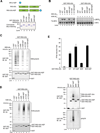Ubiquitin-induced oligomerization of the RNA sensors RIG-I and MDA5 activates antiviral innate immune response
- PMID: 22705106
- PMCID: PMC3412146
- DOI: 10.1016/j.immuni.2012.03.022
Ubiquitin-induced oligomerization of the RNA sensors RIG-I and MDA5 activates antiviral innate immune response
Abstract
RIG-I and MDA5 detect viral RNA in the cytoplasm and activate signaling cascades leading to the production of type-I interferons. RIG-I is activated through sequential binding of viral RNA and unanchored lysine-63 (K63) polyubiquitin chains, but how polyubiquitin activates RIG-I and whether MDA5 is activated through a similar mechanism remain unresolved. Here, we showed that the CARD domains of MDA5 bound to K63 polyubiquitin and that this binding was essential for MDA5 to activate the transcription factor IRF3. Mutations of conserved residues in MDA5 and RIG-I that disrupt their ubiquitin binding also abrogated their ability to activate IRF3. Polyubiquitin binding induced the formation of a large complex consisting of four RIG-I and four ubiquitin chains. This hetero-tetrameric complex was highly potent in activating the antiviral signaling cascades. These results suggest a unified mechanism of RIG-I and MDA5 activation and reveal a unique mechanism by which ubiquitin regulates cell signaling and immune response.
Copyright © 2012 Elsevier Inc. All rights reserved.
Figures







Comment in
-
No ubiquitin anchors and fully RIGged.Immunity. 2012 Jun 29;36(6):897-9. doi: 10.1016/j.immuni.2012.06.005. Immunity. 2012. PMID: 22749347
Similar articles
-
TRIM13 is a negative regulator of MDA5-mediated type I interferon production.J Virol. 2014 Sep;88(18):10748-57. doi: 10.1128/JVI.02593-13. Epub 2014 Jul 9. J Virol. 2014. PMID: 25008915 Free PMC article.
-
Reconstitution of the RIG-I pathway reveals a signaling role of unanchored polyubiquitin chains in innate immunity.Cell. 2010 Apr 16;141(2):315-30. doi: 10.1016/j.cell.2010.03.029. Cell. 2010. PMID: 20403326 Free PMC article.
-
Activation of duck RIG-I by TRIM25 is independent of anchored ubiquitin.PLoS One. 2014 Jan 23;9(1):e86968. doi: 10.1371/journal.pone.0086968. eCollection 2014. PLoS One. 2014. PMID: 24466302 Free PMC article.
-
Recent Advances and Contradictions in the Study of the Individual Roles of Ubiquitin Ligases That Regulate RIG-I-Like Receptor-Mediated Antiviral Innate Immune Responses.Front Immunol. 2020 Jun 24;11:1296. doi: 10.3389/fimmu.2020.01296. eCollection 2020. Front Immunol. 2020. PMID: 32670286 Free PMC article. Review.
-
Ubiquitin-mediated modulation of the cytoplasmic viral RNA sensor RIG-I.J Biochem. 2012 Jan;151(1):5-11. doi: 10.1093/jb/mvr111. Epub 2011 Sep 2. J Biochem. 2012. PMID: 21890623 Review.
Cited by
-
MDA5 assembles into a polar helical filament on dsRNA.Proc Natl Acad Sci U S A. 2012 Nov 6;109(45):18437-41. doi: 10.1073/pnas.1212186109. Epub 2012 Oct 22. Proc Natl Acad Sci U S A. 2012. PMID: 23090998 Free PMC article.
-
Unraveling blunt-end RNA binding and ATPase-driven translocation activities of the RIG-I family helicase LGP2.Nucleic Acids Res. 2024 Jan 11;52(1):355-369. doi: 10.1093/nar/gkad1106. Nucleic Acids Res. 2024. PMID: 38015453 Free PMC article.
-
How RIG-I like receptors activate MAVS.Curr Opin Virol. 2015 Jun;12:91-8. doi: 10.1016/j.coviro.2015.04.004. Epub 2015 May 13. Curr Opin Virol. 2015. PMID: 25942693 Free PMC article. Review.
-
IFI16 directly senses viral RNA and enhances RIG-I transcription and activation to restrict influenza virus infection.Nat Microbiol. 2021 Jul;6(7):932-945. doi: 10.1038/s41564-021-00907-x. Epub 2021 May 13. Nat Microbiol. 2021. PMID: 33986530
-
DExD/H-box RNA helicases as mediators of anti-viral innate immunity and essential host factors for viral replication.Biochim Biophys Acta. 2013 Aug;1829(8):854-65. doi: 10.1016/j.bbagrm.2013.03.012. Epub 2013 Apr 6. Biochim Biophys Acta. 2013. PMID: 23567047 Free PMC article. Review.
References
-
- Gack MU, Shin YC, Joo CH, Urano T, Liang C, Sun L, Takeuchi O, Akira S, Chen Z, Inoue S, Jung JU. TRIM25 RING-finger E3 ubiquitin ligase is essential for RIG-I-mediated antiviral activity. Nature. 2007;446:916–920. - PubMed
Publication types
MeSH terms
Substances
Grants and funding
LinkOut - more resources
Full Text Sources
Other Literature Sources
Molecular Biology Databases

